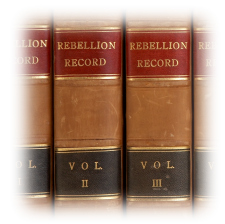–An infernal machine, designed by the Rebels to blow up the Pawnee and the vessels of the Potomac flotilla, which was set adrift near Acquia Creek, was picked up floating toward the Pawnee. The following description of the article has been sent to the Navy Department: Two large eighty-gallon oil casks, perfectly water-tight, acting as buoys, connected by twenty-five fathoms of 3 ½-inch rope, buoyed with largo squares of cork, every two feet, secured to casks by iron handles. A heavy bomb of boiler iron, fitted with a brass tap, and filled with powder, is suspended to the casks six feet under water. On top of the cask is a wooden box, with fuze in a gutta-percha tube. In the centre of the cork is a platform with a great length of fuze coiled away occupying the middle of the cask. It was intended by the contrivers of this weapon of civilized warfare, that the shock of a collision should light the fuze. The machine was first discovered by the Pawnee while lying off Acquia Creek, in company with the Freeborn and two or three other vessels. The commander of the former, on seeing the object toward the fleet, sent out a small boat’s crew to make an investigation.–N. Y. Tribune, July 13.
–This morning, at an early hour, a considerable body of Secessionists made their appearance at the Great Falls, above Washington, opposite Major Gerhardt’s command, Eighth German Battalion, of about two hundred men, and commenced firing. Major Gerhardt’s battalion returned the fire, and after the exchange of a few volleys, “nobody hurt,” the rebels retired, but returned again this afternoon about five o’clock with reinforcements comprising a body of cavalry. The firing was kept up with spirit on both sides for several hours, and two men of Major Gerhardt’s command were mortally wounded and have since died–privates George Riggs and Martin Ohl. No other men were wounded on the Union side, but Major Gerhardt’s sharp-shooters emptied several saddles on the other side, and suppose they must have killed at least a dozen before the enemy retired. Gerhardt’s men are anxious to cross the river and meet their enemies hand to hand if they can be found. The firing from the other side was all along the shore from near Dickey’s tavern to above the Falls. Both Riggs and Ohl belonged to Company B, Turner Rifles. Both were married men, and the last words of Ohl was a message to his wife “not to grieve for him; that he died for liberty and his country.”–National Intelligencer, July 9.
–It having been ascertained to the satisfaction of the War Department that Captain Manry, Assistant Adjutant General; Captain Carter L. Stevenson, of the Fifth Infantry; and Second Lieutenant Dillon, of the Sixth Infantry, entertain and have expressed treasonable designs against the Government of the United States, their names, according to General Order No. 87, were stricken from the rolls of the army; and also Major Albert J. Smith, Paymaster, for having deserted his post at Key West, Florida.–Army Order No. 88.
–The Twenty-third Regiment N. Y. S. V., arrived at Washington. It is commanded by Colonel H. C. Hoffman.–National Intelligencer, July 9.
–Mb. Vallandigham, of Ohio, visited, this afternoon, the Ohio encampments in Virginia, and was greeted with the sight of a hanging effigy, bearing the inscription: “Vallandigham, the traitor.” When he approached the Second Ohio Regiment, he was saluted by a discharge of stones, and, on the interposition of the officers, they were also pelted, until it amounted almost to a riot. He was finally released from his unpleasant position.–N. Y. Tribune, July 8.
–Very impressive and interesting services took place in the Church of the Messiah in New York this evening. The exercises were chosen with special reference to their fitness for the first Sunday after National Independence. The services began with Collins’ Requiem of Heroes:
“How sleep the brave who sink to rest,
By all their country’s wishes blest!”
Then followed the xlviith Psalm, slightly modified, the minister rending a verse and the congregation responding with the alternate one. Dr. Osgood made the prayer, and afterward the choir sang the “March of Liberty.” The beginning of this sacred song is:
“No battle-brand shall harm the free,
Led on by Christ our Liberty!*
This was succeeded by Psalm csivii., read by the minister and people; lesson from the Old Testament–the Promised Land–Deut, viii.; chanted Psalm–Cantate Domino; lesson from the New Testament–Christ weeping over Jerusalem–Matt, xxiii.; and Gloria in Excelsis.
The subject of Dr. Osgood’s brief extempore discourse was “God with Nations,” in which he showed that the august feature of modern civilization was the consecration of nationality.
–The New Orleans Picayune published an elaborate article upon the celebration of the Fourth of July, in which it stated that the present rebellion is “based upon the same eternal principles which justified and glorified the patriots of 1776.”–(Doc. 72.)
